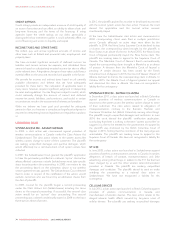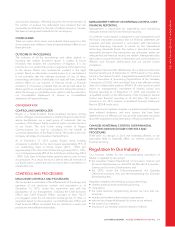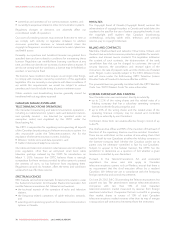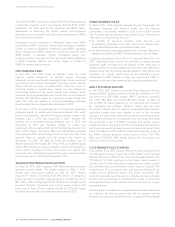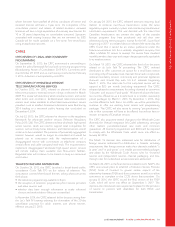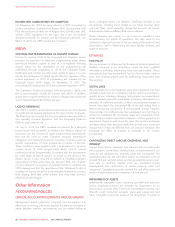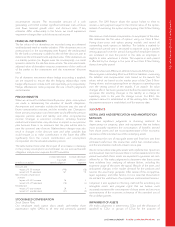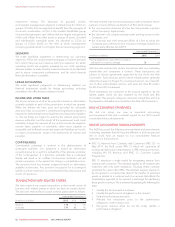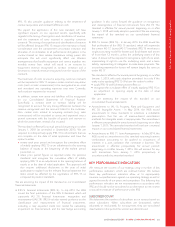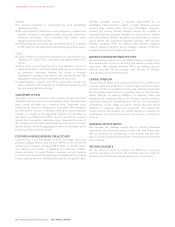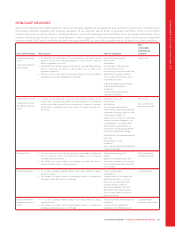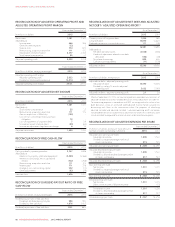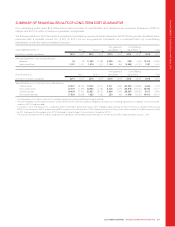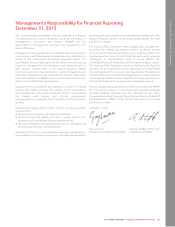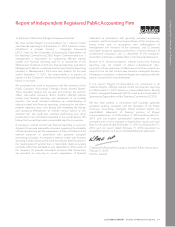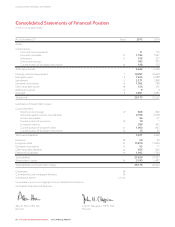Rogers 2015 Annual Report Download - page 86
Download and view the complete annual report
Please find page 86 of the 2015 Rogers annual report below. You can navigate through the pages in the report by either clicking on the pages listed below, or by using the keyword search tool below to find specific information within the annual report.MANAGEMENT’S DISCUSSION AND ANALYSIS
Wireless
• A wireless subscriber is represented by each identifiable
telephone number.
• We report wireless subscribers in two categories: postpaid and
prepaid. Postpaid and prepaid include voice-only subscribers,
data-only subscribers, and subscribers with service plans
integrating both voice and data.
• Wireless prepaid subscribers are considered active for a period
of 180 days from the date of their last revenue-generating usage.
Cable
• Cable Television and Internet subscribers are represented by a
dwelling unit; Cable Phone subscribers are represented by line
counts.
• When there is more than one unit in one dwelling, such as an
apartment building, each tenant with cable service is counted as
an individual subscriber, whether the service is invoiced
separately or included in the tenant’s rent. Institutional units, like
hospitals or hotels, are each considered one subscriber.
• Cable Television, Internet, and Phone subscribers include only
those subscribers who have service installed and operating, and
who are being billed accordingly.
SUBSCRIBER CHURN
Subscriber churn is a measure of the number of subscribers that
deactivated during a period as a percentage of the total subscriber
base, usually calculated on a monthly basis. Subscriber churn
measures our success in retaining our subscribers. We calculate it
by dividing the number of Wireless subscribers that deactivated
(usually in a month) by the aggregate numbers of subscribers at
the beginning of the period. When used or reported for a period
greater than one month, subscriber churn represents the sum of
the number of subscribers deactivating for each period incurred
divided by the sum of the aggregate number of subscribers at the
beginning of each period incurred.
POSTPAID AVERAGE REVENUE PER ACCOUNT
Commencing in the first quarter of 2015, we began disclosing
postpaid average revenue per account (ARPA) as one of our key
performance indicators. PostpaidARPAhelpsusidentifytrends
and measure our success in attracting and retaining multiple-
device accounts. A single Wireless postpaid account typically
provides subscribers with the advantage of allowing for the pooling
of plan attributes across multiple devices and on a single bill. Each
Wireless postpaid account is typically represented by an
identifiable billing account number. A single Wireless postpaid
account may include more than one identifiable telephone
number and receive monthly Wireless services for a variety of
connected devices including smartphones, basic phones, tablets,
and other devices. Wireless postpaid accounts under our various
brand names are considered separate accounts. We calculate
Wireless postpaid ARPA by dividing total Wireless postpaid
network revenue (monthly) by the average number of Wireless
postpaid accounts for the same time period.
BLENDED AVERAGE REVENUE PER USER
Blended average revenue per user (ARPU) helps us identify trends
and measure our success in attracting and retaining higher value
subscribers. We calculate blended ARPU by dividing network
revenue (monthly) by the average total number of Wireless
subscribersforthesametimeperiod.
CAPITAL INTENSITY
Capital intensity allows us to compare the level of our additions to
property, plant and equipment to that of other companies within
the same industry. Our additions to property, plant and equipment
do not include expenditures on spectrum licences. We calculate
capital intensity by dividing additions to property, plant and
equipment by operating revenue. For Wireless, capital intensity is
calculated using total network revenue. We use it to evaluate the
performance of our assets and when making decisions about
additions to property, plant and equipment. We believe that
certain investors and analysts use capital intensity to measure the
performance of asset purchases and construction in relation to
revenue.
DIVIDEND PAYOUT RATIOS
We calculate the dividend payout ratio by dividing dividends
declared for the year by net income or free cash flow for the year.
We use dividends as a percentage of net income and free cash
flow to conduct analysis and assist with determining the dividends
we should pay.
RETURN ON ASSETS
We use return on assets to measure our efficiency in using our
assets to generate net income. We calculate return on assets by
dividing net income for the year by total assets as at year-end.
84 ROGERS COMMUNICATIONS INC. 2015 ANNUAL REPORT


